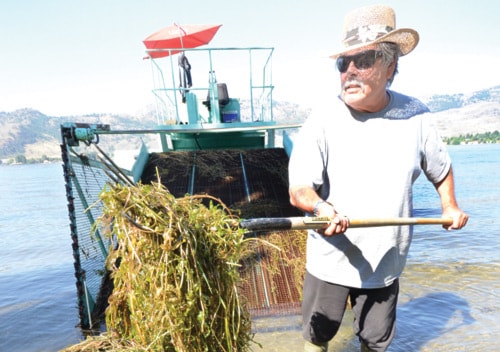A US control board’s application to use a chemical herbicide in Osoyoos Lake has drawn concerns from north of the boarder.
The (American) Okanogan County Noxious Weed Control Board has applied to a national environmental agency to treat Eurasian water milfoil with an aquatic herbicide.
However, with Canadians having moved away from aquatic chemical control of milfoil decades ago — not to mention a seemingly upcoming province-wide ban on cosmetic pesticides in B.C. — the Okanagan Basin Water Board would like their American counterparts to utilize other methods of removing the water weeds from the cross-border lake.
In a letter to the American board, OBWB chair and Osoyoos mayor Stu Wells said the herbicide could negatively affect the Canadian end of the lake.
“The hydrology of Osoyoos Lake and the back-swelling Okanagan River would make it possible for chemicals applied south of the border to mix into the northern half of the lake,” said Wells. “The potential risks to the ecosystem, drinking and agricultural water intakes, residents, and visitors on the Canadian side of the lake are unknown and may violate the Boundary Waters Treaty.”
Wells noted the treaty states that shared waters “shall not be polluted on either side to the injury of health or property on the other,” while requesting the American board conduct a full consultation on both sides of the border before proceeding.
“The OBWB believes that there are effective alternatives to chemical control that should be explored including harvesting, rototilling and hand-pulling by divers. Biological control through augmentation of native insects might also hold promise,” he wrote. “The OBWB is open to working with the OCNWCB and residents of Osoyoos Lake in pursuing a more environmentally and socially acceptable method of control.”
Wells told the Western News Wednesday he is hopeful a compromise can be reached with his American counterparts and that maybe they will develop a program similar to the one the OBWB has employed for decades.
“In the fall/winter window we use a rototiller which is like a regular garden rototiller only it operates in up to about 15 feet of water. So, we use that to rototill the lake bottom and remove the roots; and that is effective,” said Wells.
“In the summertime, we have areas where we didn’t get to in the wintertime because we miss them or where there were fast growing patches. So, we go into harvesting program which is basically just cosmetic. We go down a couple of metres, cut it off and remove it from the water.”
Wells said because the milfoil makes such great fertilizer, staff has no trouble getting rid of it.
“It is so loaded with nutrients, it is just hot. After four days you wouldn’t even be able to put your hand in the pile,” he said. “We dump it on the shore and people come with their trailers and trucks to scoop it up. It is just a great, great compost producer.”
According to Wells, the program is quite expensive, costing several hundreds of thousands of dollars a year. However, Wells said he considers it money well spent.
“When you are dealing with water that is used for agriculture or drinking, we certainly don’t believe that we should be putting chemicals into it,” he asserted.
Wells said with the Americans not having a program to deal with milfoil for so many years, he can understand why property owners along their portion of the lake are upset. Last winter the OBWB’s equipment malfunctioned, he said, and there were portions of the Canadian half of the lake that did not get harvested.
“There was a tremendous amount of growth in the places we weren’t able to get to,” Wells said. “People could not use their lakefront. The milfoil had become a very dense mat. You definitely couldn’t swim through it and you couldn’t get a boat through it, so people got anxious.”
Wells, however, did question American claims that the milfoil led to five drownings last year.
“It is interesting that they come up with that now, that it is a safety issue and they have these five related drownings,” he said. “I haven’t heard of any (milfoil related drownings). I don’t know of any in Canada. I think I would want to see the coroner’s reports.”
In addition to the OBWB’s letter, Wells said the BC Minister of Environment Dr. Terry Lake has also sent a letter to the American weed control board. So far, Wells said the Americans have not responded to his letter, although he said there has been lots of documentation exchanged between the two sides.
“I just hope we can have some dialogue and maybe have a collaborative solution to it,” Wells said. “Maybe we can help. Maybe we can get our crew down there.
“We have our harvesters sitting right at the border right now working on Osoyoos Lake. All we have that is stopping them from scooping down, cutting out the milfoil and solving their problems in about four days time is an imaginary line.”
